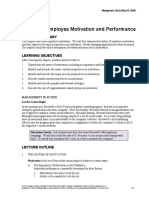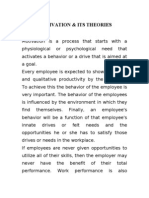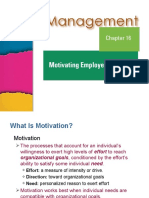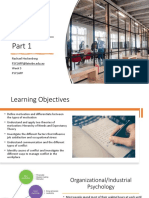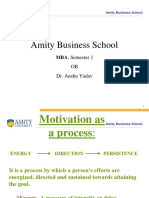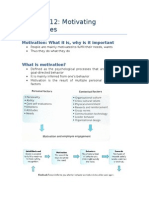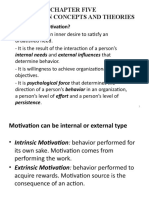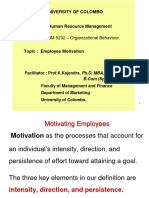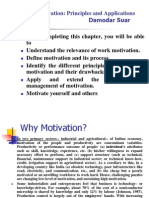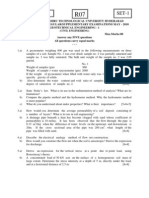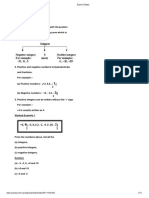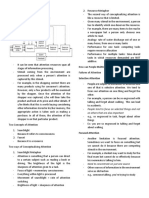Chapter 16: Motivation
Motivation is the set of forces that cause people to behave in certain ways
Importance of Motivation in the Workplace:
Motivation: The desire to do the job.
Ability: The capability to do the job.
Work environment: The resources needed to do the job.
Traditional Approach:
Economic gain was the primary thing that motivated employees.
Money was more important to employees that the nature of the job.
Employees could be expected to perform any kind of job if they were paid.
Human Relations Approach:
It emphasizes the role of social processes in the workplace.
Employees want to feel useful and important.
Are these social needs more important than money? - yes
Maslow’s hierarchy of needs: Suggests that people must satisfy five groups of needs in order— physiological,
security, belongingness, esteem, and self-actualization
Physiological needs—things such as food, sex, and air, which represent basic issues of survival and biological
function. In organizations, survival needs are generally satisfied by adequate wages and the work environment
itself, which provides restrooms, adequate lighting, comfortable temperatures, and ventilation.
Security needs - for a secure physical and emotional environment. Examples include the desire for housing and
clothing and the need to be free from worry about money and job security. These needs can be satisfied in the
workplace by assured job continuity, an effective grievance system, and an adequate insurance and retirement
benefit package
Belongingness needs - relate to social processes. They include the need for love and companionship and the need
to be accepted by one’s peers. A manager can help satisfy these needs by allowing social interaction and by making
employees feel like part of a team or work group
Esteem needs - actually comprise two different sets of needs: the need for a positive self-image and self-respect
and the need for recognition and respect from others. A manager can help address these needs by providing a
variety of extrinsic symbols of accomplishment, such as job titles, nice offices, and similar rewards as appropriate.
Self-actualization needs – realizing one’s potential for continued growth and individual development. A manager
could give employees a chance to participate in making decisions about their work and the opportunity to learn
new things.
Suppose you are the HR manager of a Bangladeshi organization. Mention some incentives of motivating
employees in your organization.
1. Job certainty and safety 6. Acknowledgement and admiration of work done
2. Career growth and advancement at workplace 7. Job responsibility
3. Quality working environment 8. Fair and reasonable organizational rules and policies
4. Satisfactory remuneration and salary package 9. Managerial assistance to resolve problems
5. Fascinating and exciting job 10. Opportunity to develop new job skills
What are the three perspectives of motivation?
� 1. Historical Perspectives on Motivation: • Maslow’s Hierarchy of Needs
• The Traditional Approach • The ERG Theory
• The Human Relations Approach • The Two Factor Theory
• The Human Resource Approach • Individual Human Need
2. Content Perspectives on Motivation 3. Reinforcement Perspectives of Motivation
The Need Hierarchy Approach • Positive-and Negative Reinforcement
Two-Factor Theory:
• Suggests that people’s satisfaction and dissatisfaction are influenced by two independent set of factors.
• Motivation factors: • Hygiene factors:
Achievement Supervisors
Recognition Working conditions
The work itself Interpersonal relations
Responsibility Pay and security
Advancement and growth Company policies and administration
The two-factor theory suggests that job satisfaction has two dimensions. A manager who tries to motivate an
employee using only hygiene factors, such as pay and good working conditions, will likely not succeed. To
motivate employees and produce a high level of satisfaction, managers must also offer factors such as responsibility
and the opportunity for advancement (motivation factors).
Individual Human Needs
• Need for achievement:
– The desire to accomplish a goal or task more effectively than in the past.
• Need for affiliation:
– The desire for human companionship and acceptance.
• Need for power:
– The desire to be influential in a group and to control one’s environment.
Expectancy theory Suggests that motivation depends on two things—
how much we want something how likely we think we are to get it
Equity theory contends that people are motivated to seek social equity in the rewards they receive for performance
3. Reinforcement Perspectives of Motivation
– Positive reinforcement. – Punishment.
– Avoidance. – Extinction.
Alternative Forms of Work Arrangements
Variable Work Schedules
Flexible Work Schedules: Work schedules that allow employees to select, within broad parameters, the hours
they work
Job Sharing: When two part-time employees share one full-time job
Telecommuting: Allowing employees to spend part of their time working offsite, usually at home
Merit Rewarding Systems: The formal and informal mechanisms by which employee performance is defined,
evaluated, and rewarded
Team and Group Incentive Reward Systems
Empowerment The process of enabling workers to set their own work goals, make decisions, and solve problems
within their sphere of responsibility and authority
Participation The process of giving employees a voice in making decisions about their own work








